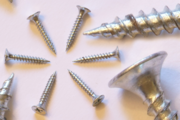Screw Lesson
Screws
This lesson is intended to address the BC Grade 5 Physical Science Learning Outcomes but may be adapted to suit a wide range of grade levels from Primary to Intermediate.
Students will be able to
|
Introductory Note
The teacher will guide students to discover how screws work. The teacher will need to prepare an observation sheet for students to record the following information: type of head on the screw, the length, the threads (close together of farther apart), how many turns to screw it completely into the wood, and conclusion.
Materials
- wood screws of various lengths,and sizes, heads
- multi-tip screwdrivers (enough for every pair of students)
- blocks of soft wood (scraps from local carpenters)
- class set of observation sheets
- cm ruler
Procedure
- Divide the class into pairs
- Give each pair a couple of blocks of wood, a multi-tip screwdriver, a variety of screws
- Direct students to examine a screw before they try to use in the blocks of wood. Observe and record the head, the thread, the length of the screw.
- Students then count how many turns it takes to put the screw completely into the the wood and record.
- Students do so with 4 or 5 screws.
- Students draw conclusions about the features of a screw that make it easier or harder to use and record.
What conclusions did you reach about screws? A greater number of turns will be required when using screws with threads closer together, but the work will be easier. Screws with threads farther apart require less turns but are harder to turn. What are some real life examples of screws? ( snowblowers, augers, wood screws, spiral staircases, etc.)
Extensions
- How is a screw related to an inclined plane?
- Can you think of a way to demonstrate this using a paper triangle and a pencil?
Return to: Simple Machines
